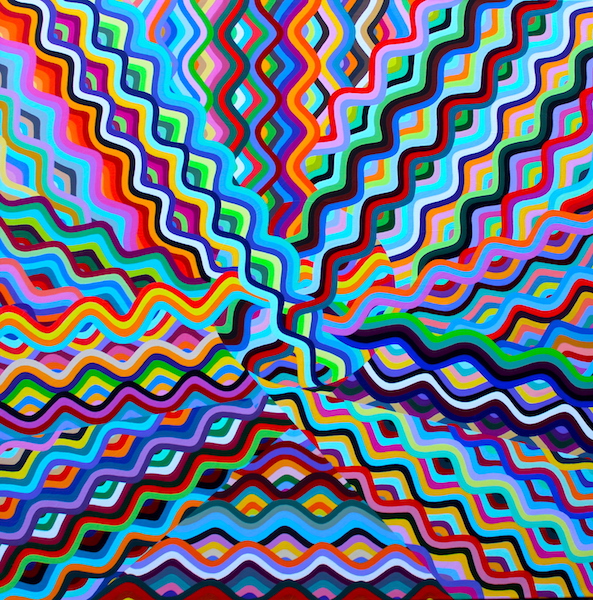
Acrylic on canvas | 164 x 168 cm | £11,000
Interpretation of x_n+1=\mu x_n (1-x_n)
by Prof. D.T. Papageorgiou, Department of Mathematics, Imperial College London
By its physical nature the painting is a projection into 2-dimensional spaceof a tangle of trajectories that are initially covering 3-dimensional space.The 3-dimensional tangle is itself a projection from a higher dimension -nature is full of examples where the initial dynamics are in infinite dimensions. A ball of trajectories in 3 dimensions (e.g. the trail of a randomly flying fly in a sphere) becomes an overlaying of trajectories in a lower dimension - the canvas. What is the signature of such a motion and how can we project it further in order to extract its dynamical essence? The painting’s title underpins such an exploration. It is a map that sends one number (i.e. geometrical position) to another (this is the trajectory), then the new number maps to the next one, and the process continues ad infinitum to produce an object (the attractor) that is a fractal with self-similar geometry - however much you zoom in the geometry is reproduced. The painting’s map is analogous - any plane in 3 dimensions (a line on the canvas) will be pierced by the trajectories of the tangle. One piercing gives rise to the next one as the trajectory traverses 3 dimensional space to be projected onto the 2 dimensional plane we have selected - this is the Poicare map of the flow. A geometrical object self-assembles starting from an initial condition, that contains the essence and signature of the high dimensional tangle. The trajectories in the painting have finite thickness and probably contain their own tangles of trajectories with their own complex geometries constrained in deforming and entangled tori. The process repeats ad infinitum. Chaos within order, and order within chaos.

Acrylic on canvas | 160 x 160 cm | £8,000

Acrylic on canvas | 153 X 153 £7,500

Acrylic on canvas | 122 X 122 £3,500

acrylic on canvas



acrylic on canvas





acrylic on canvas

oil on canvas

oil on canvas















Acrylic on canvas | 164 x 168 cm | £11,000
Interpretation of x_n+1=\mu x_n (1-x_n)
by Prof. D.T. Papageorgiou, Department of Mathematics, Imperial College London
By its physical nature the painting is a projection into 2-dimensional spaceof a tangle of trajectories that are initially covering 3-dimensional space.The 3-dimensional tangle is itself a projection from a higher dimension -nature is full of examples where the initial dynamics are in infinite dimensions. A ball of trajectories in 3 dimensions (e.g. the trail of a randomly flying fly in a sphere) becomes an overlaying of trajectories in a lower dimension - the canvas. What is the signature of such a motion and how can we project it further in order to extract its dynamical essence? The painting’s title underpins such an exploration. It is a map that sends one number (i.e. geometrical position) to another (this is the trajectory), then the new number maps to the next one, and the process continues ad infinitum to produce an object (the attractor) that is a fractal with self-similar geometry - however much you zoom in the geometry is reproduced. The painting’s map is analogous - any plane in 3 dimensions (a line on the canvas) will be pierced by the trajectories of the tangle. One piercing gives rise to the next one as the trajectory traverses 3 dimensional space to be projected onto the 2 dimensional plane we have selected - this is the Poicare map of the flow. A geometrical object self-assembles starting from an initial condition, that contains the essence and signature of the high dimensional tangle. The trajectories in the painting have finite thickness and probably contain their own tangles of trajectories with their own complex geometries constrained in deforming and entangled tori. The process repeats ad infinitum. Chaos within order, and order within chaos.
Acrylic on canvas | 160 x 160 cm | £8,000
Acrylic on canvas | 153 X 153 £7,500
Acrylic on canvas | 122 X 122 £3,500
acrylic on canvas
acrylic on canvas
acrylic on canvas
oil on canvas
oil on canvas